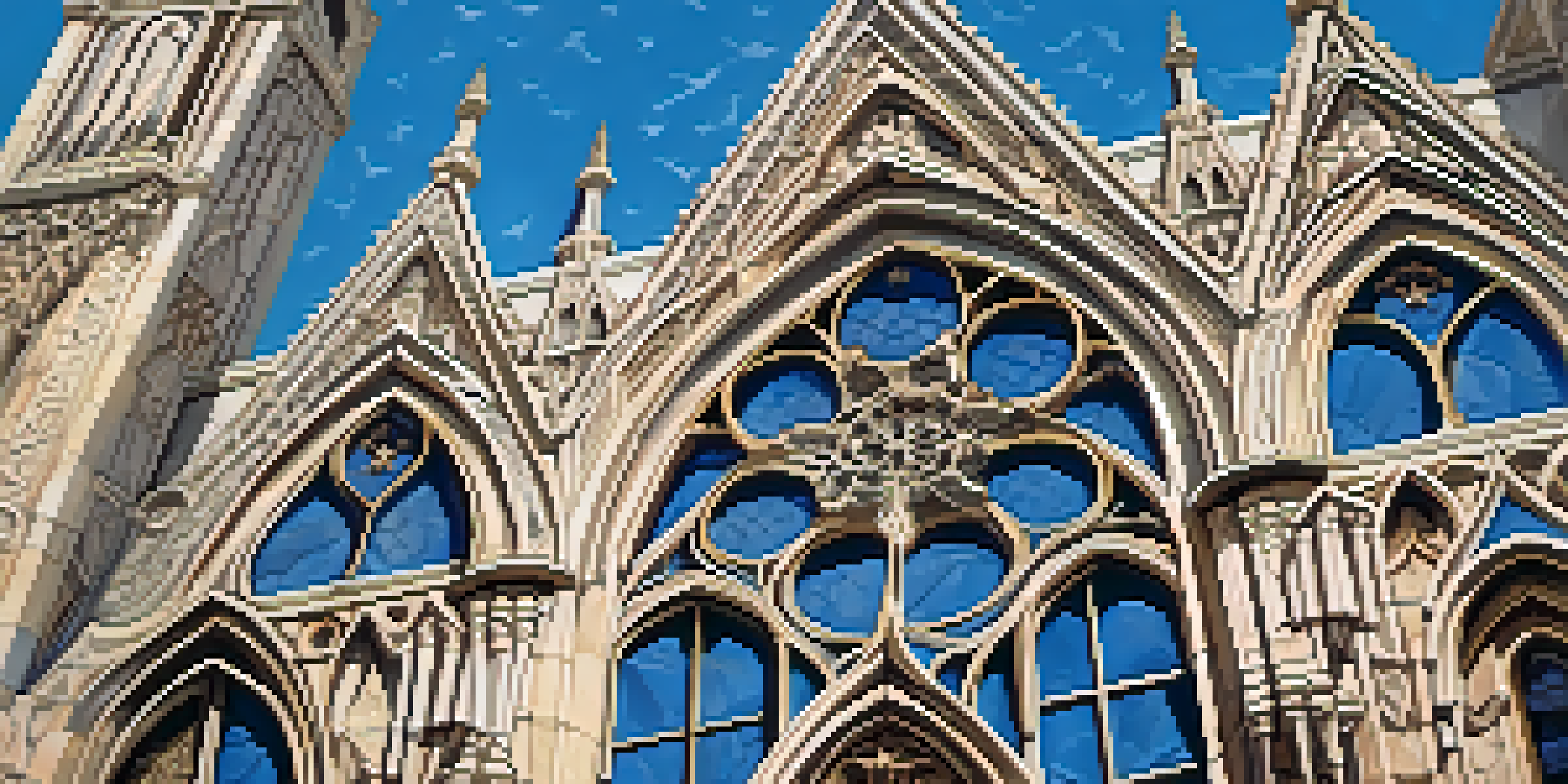Cultural Significance of Carved Stone in Modern Structures

Understanding Carved Stone: A Brief Overview
Carved stone has been a vital part of architectural history, symbolizing craftsmanship and artistic expression. This ancient technique involves shaping natural stone into intricate designs, often reflecting cultural narratives. From ancient temples to modern skyscrapers, carved stone serves as a bridge between past traditions and contemporary design.
Architecture is the learned game, correct and magnificent, of forms assembled in the light.
While many modern buildings favor minimalism and glass, the inclusion of carved stone can create a tactile connection to history. It allows architects to infuse character into their designs, making structures more relatable and meaningful. This blend of old and new often results in captivating visual statements that tell stories.
In today's fast-paced world, carved stone stands as a reminder of the value of patience and skill in craftsmanship. It encourages a deeper appreciation for materials and techniques that have been passed down through generations. By revisiting this art form, modern architecture can celebrate its roots while embracing innovation.
Carved Stone as Cultural Identity in Architecture
Carved stone often plays a crucial role in expressing cultural identity within architecture. Each region has unique styles, motifs, and symbolism that resonate with its history and people. For instance, Gothic cathedrals are known for their elaborate stone carvings that depict biblical stories, making the divine accessible to the public.

Modern architects are increasingly turning to these traditional methods to convey a sense of place. By incorporating local stone and indigenous designs, buildings can reflect their surroundings and the heritage of the communities they serve. This not only enhances the aesthetic appeal but also fosters a sense of belonging among residents.
Carved Stone Connects Cultures
Carved stone serves as a vital expression of cultural identity in architecture, reflecting unique regional styles and fostering community pride.
Moreover, when communities see their cultural symbols represented in architecture, it reinforces their identity. This connection can evoke pride and respect for local history, making carved stone a powerful tool for cultural storytelling in modern structures.
The Role of Technology in Carving Stone Today
Advancements in technology have revolutionized the art of stone carving, making it more accessible and precise. Tools like CNC (Computer Numerical Control) machines allow for intricate designs to be replicated with remarkable accuracy. This not only saves time but also enables architects to experiment with complex patterns that were once labor-intensive.
Every great architect is - necessarily - a great poet. He must be a great original thinker whilst being inspired by the past.
Despite these technological advancements, the human touch remains irreplaceable in stone carving. Skilled artisans bring intuition and creativity to the process, ensuring that each piece resonates with emotion and intent. The collaboration between modern technology and traditional craftsmanship creates a unique synergy that enhances the final product.
As a result, we are witnessing a renaissance of carved stone in modern architecture. This blend of old and new offers exciting possibilities for innovative designs that respect tradition while pushing boundaries. The future of carved stone looks promising as architects continue to explore its potential.
Sustainability and Carved Stone in Architecture
Sustainability is a growing concern in modern architecture, and carved stone presents an eco-friendly option. Natural stone is durable and requires minimal maintenance, making it a sustainable choice for long-lasting structures. Additionally, sourcing locally can reduce the carbon footprint associated with transportation.
Furthermore, the longevity of carved stone means that buildings remain relevant and functional for decades, even centuries. This contrasts sharply with many modern materials that may need replacement or renovation over time. By choosing carved stone, architects can contribute to sustainable design principles while creating timeless beauty.
Technology Enhances Stone Carving
Modern technology, like CNC machines, allows for precise stone carving while preserving the invaluable human touch of skilled artisans.
Integrating carved stone into modern structures not only benefits the environment but also enhances aesthetic value. It adds a unique character that sets buildings apart, allowing them to age gracefully. As sustainability becomes a priority, carved stone can play a crucial role in shaping the future of architecture.
Emotional Impact of Carved Stone in Modern Design
The emotional resonance of carved stone is profound, often evoking feelings of nostalgia and connection. When people interact with buildings that feature intricate stone carvings, they are reminded of their cultural heritage and shared history. This emotional connection can enhance the overall experience of a space, making it more memorable.
Architects understand the power of emotion in design, often using carved stone to create focal points that draw attention. These elements invite exploration, encouraging visitors to engage with their surroundings on a deeper level. The tactile nature of stone invites touch and interaction, further enhancing the emotional experience.
In a world where many structures feel impersonal, carved stone provides warmth and a sense of belonging. It reminds us of the importance of storytelling in architecture, as each carved detail can convey a narrative. This emotional impact makes carved stone a valuable asset in modern design.
Case Studies: Carved Stone in Iconic Modern Structures
Several modern structures have successfully integrated carved stone, showcasing its cultural significance and aesthetic appeal. For instance, the National Cathedral in Washington, D.C., features stunning stone carvings that reflect the rich history of the nation. These carvings not only beautify the building but also serve as reminders of the shared values and beliefs that define the community.
Another example is the Sydney Opera House, where sculptural forms crafted from stone and concrete create an iconic silhouette. The use of stone in its design adds a tactile dimension that enhances the overall experience of the space. Visitors are drawn to the intricate details, each telling a story of creativity and craftsmanship.
Sustainable Beauty in Architecture
Carved stone is an eco-friendly choice that adds aesthetic value and longevity to structures, aligning with contemporary sustainability goals.
These case studies highlight how carved stone can elevate modern architecture, making it a timeless addition to contemporary design. By looking to successful examples, architects can draw inspiration for their own projects, ensuring that the cultural significance of carved stone endures.
Future Trends: The Evolution of Carved Stone in Architecture
Looking ahead, the future of carved stone in architecture is bright, with new trends emerging that blend tradition with innovation. As sustainability continues to shape design practices, architects are more likely to explore local materials, including stone, that can be carved to reflect cultural narratives. This trend not only honors the past but also meets contemporary needs.
Additionally, the integration of digital design tools is paving the way for more elaborate and personalized carvings. Architects can experiment with designs that push boundaries, creating unique features that resonate with their vision. This evolution allows for a dynamic interplay between artistry and technology, ensuring that carved stone remains relevant in the modern landscape.

As we embrace these trends, carved stone will undoubtedly find its place in future architectural masterpieces. By continuing to explore its cultural significance, we ensure that this art form not only survives but thrives in a world that values both tradition and innovation.